Åland Islands
The Åland Islands or Åland (/ˈɔːlənd, ˈɑːlənd/, also US: /ˈoʊlənd, ˈoʊlɑːn(d), ˈɑːlɑːnd/,[7][8][9][10] Swedish: [ˈǒːland], Finland Swedish: [ˈoːlɑnd]; Finnish: Ahvenanmaa [ˈɑhʋenɑnˈmɑː]) is an archipelago province at the entrance to the Gulf of Bothnia in the Baltic Sea belonging to Finland. It is autonomous, demilitarised and is the only monolingually Swedish-speaking region in Finland. It is the smallest region of Finland, constituting 0.51% of its land area and 0.54% of its population.
Åland Islands | |
|---|---|
Autonomous region of Finland | |
 Flag  Coat of arms | |
| Motto(s): "Islands of Peace"[1] | |
| Anthem: "Ålänningens sång" (Swedish) (English: "Song of the Ålander") | |
 Location of Åland within Finland | |
| Sovereign state | Finland |
| Autonomy granted | 7 May 1920[2] |
| EU accession | 1 January 1995 |
| Capital and largest city | Mariehamn 60°07′N 019°54′E |
| Official languages | Swedish |
| Demonym(s) |
|
| Government | Devolved parliamentary autonomous region |
• Governor | Peter Lindbäck |
• Premier | Veronica Thörnroos |
| Legislature | Lagting |
| Area | |
• Total | 1,580[3] km2 (610 sq mi) (unranked) |
| Highest elevation | 129.1 m (423.6 ft) |
| Population | |
• 2019 estimate | 29,884[4] |
• Density | 18.36/km2 (47.6/sq mi) |
| GDP (PPP) | 2007 estimate |
• Total | $1.563 billion[5] |
• Per capita | $55,829 |
| HDI (2017) | 0.900[6] very high |
| Currency | Euro (€) (EUR) |
| Time zone | UTC+02:00 (EET) |
| UTC+03:00 (EEST) | |
| Date format | dd.mm.yyyy |
| Driving side | right |
| Calling code | +358 18 |
| ISO 3166 code |
|
| Internet TLD | .ax |
Åland comprises Fasta Åland on which 90% of the population resides[11] and a further 6,500 skerries and islands to its east.[12] Fasta Åland is separated from the coast of Sweden by 38 kilometres (24 mi) of open water to the west. In the east, the Åland archipelago is contiguous with the Finnish Archipelago Sea. Åland's only land border is located on the uninhabited skerry of Märket, which it shares with Sweden.[13]
Åland's autonomous status means that those provincial powers normally exercised by representatives of the central Finnish government are largely exercised by its own government.
Autonomy
The autonomous status of the islands was affirmed by a decision made by the League of Nations in 1921 following the Åland Islands dispute. It was reaffirmed within the treaty admitting Finland to the European Union. By law, Åland is politically neutral and entirely demilitarised, and residents are exempt from conscription to the Finnish Defence Forces. The islands were granted extensive autonomy by the Parliament of Finland in the Act on the Autonomy of Åland of 1920, which was later replaced by new legislation by the same name in 1951 and 1991. The constitution of Finland defines a "constitution of Åland" by referring to this act. Åland remains exclusively Swedish-speaking by this act.[14]
In connection with Finland's admission to the European Union, a protocol was signed concerning the Åland Islands that stipulates, among other things, that provisions of the European Community Treaty shall not force a change of the existing restrictions for foreigners (i.e., persons who do not enjoy "home region rights"—hembygdsrätt—in Åland) to acquire and hold real property or to provide certain services.[15]
Etymology
Åland's original name was in the Proto-Norse language *Ahvaland which means "land of water". Ahva is related to the Latin word for water, "aqua". In Swedish, this first developed into Áland and eventually into Åland, literally "river land"—even though rivers are not a prominent feature of Åland's geography. The Finnish and Estonian names of the island, Ahvenanmaa and Ahvenamaa ("perch land"), are seen to preserve another form of the old name.[16]
Another theory suggests that the Finnish Ahvenanmaa would be the original name of the archipelago, from which the Swedish Åland derives.[17]
The official name, Landskapet Åland, means "the Region of Åland"; landskap is cognate to English "landscape".
History

Members of the Neolithic Comb Ceramic culture started settling the islands some 7000 years ago, after the islands had begun to re-emerge from the sea after being pushed down by the weight of the continental ice of the latest ice-age. Two neolithic cultures met on Åland: the Comb Ceramic culture and the later Pit-Comb Ware culture which spread from the west.[18]
Stone Age and Bronze Age people obtained food by hunting seals and birds, fishing, and gathering plants. They also started agriculture early on. In the Iron Age, contacts with Scandinavia increased.. From the iron age, Åland have six hillforts. From the Viking age there are over 380 documented burial sites.[18]
Along with Finland, the Åland Islands formed part of the territory ceded to Russia by Sweden under the Treaty of Fredrikshamn in September 1809. As a result, they became part of the semi-autonomous Grand Duchy of Finland (1809-1917). During negotiations, Sweden failed to secure a provision that the islands not be fortified. The issue was important not only for Sweden but also for the United Kingdom, which as a result of the Treaty of 1809 became concerned that a Russian military presence on the islands could threaten Britain's commercial interests in its trade passing through the Baltic to Helsingfors..
In 1832, Russia started to fortify the islands, with the great fortress of Bomarsund. In 1854, as part of the campaign in the Baltic during the Crimean War against Russia, a combined British and French force of warships and marines captured and destroyed the fortress. The 1856 Treaty of Paris demilitarised the entire Åland archipelago.[19]
During the Finnish Civil War, in 1918, Swedish troops intervened as a peacekeeping force between the Russian troops stationed on the islands and "White" and "Red" Finnish troops who came from Finland over the frozen sea. Within weeks, the Swedish troops gave way to German troops who occupied Åland at the request of the "White" (conservative) Senate of Finland.
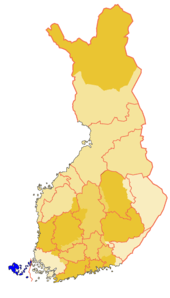
After 1917, the residents of the islands worked towards having them ceded to Sweden. In 1919 96.4% of the voters on the islands signed a petition for secession from Finland and for integration with Sweden, with over 95% in favour.[20] Swedish nationalist sentiments had strengthened particularly as a result of the anti-Swedish tendencies in Finland and as a result of Finnish nationalism fueled by Finland's struggle to retain its autonomy and resistance against Russification. The conflict between the Swedish-speaking minority and the Finnish-speaking majority on the Finnish mainland, prominent in Finnish politics since the 1840s, contributed to the apprehension of the Åland population about a future within Finland.
Finland, however, declined to cede the islands and instead offered the islanders an autonomous status. Nevertheless, the residents did not approve the offer, and in 1921 the dispute over the islands went before the newly-formed League of Nations. The latter decided that Finland should retain sovereignty over the province, but that the Åland Islands should be made an autonomous territory. The Åland convention of 20 October 1921, signed by Sweden, Finland, Germany, the United Kingdom, France, Italy, Denmark, Poland, Estonia, and Latvia, was the first international agreement achieved by the League.[21] Thus, Finland was obliged to ensure the residents of the Åland Islands the right to maintain the Swedish language, as well as their own culture and local traditions. The convention of 1921 established the neutral status of Åland by international treaty, prohibiting the placing of military installations or forces on the islands.[22]
The islanders’ disappointment about insufficient support from Sweden in the League of Nations, Swedish disrespect for Åland's demilitarised status in the 1930s, and some feelings of a shared destiny with Finland during and after the Second World War, changed their perception of their relationship with Finland from "a Swedish province in Finnish possession" to "an autonomous part of Finland".[23] The islanders enjoyed safety at sea during the war of 1939–1945, as their merchant fleet could sail both for the Allied countries and for Germany. Consequently, Åland shipping was not generally attacked, as the various military forces rarely knew which cargo was being carried or to whom.
Finland marked the 150th anniversary of the demilitarisation of the Åland Islands by issuing a high-value commemorative coin, the €5 150th Anniversary of Demilitarisation of Åland Islands commemorative coin, minted in 2006. The obverse depicts a pine tree, a typical feature of the Åland Islands. The reverse features a boat's stern and rudder, with a dove perched on the tiller, a symbol of 150 years of peace.
Politics
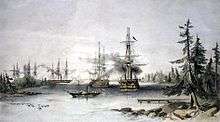
The Åland Islands are governed according to the Act on the Autonomy of Åland and international treaties. These laws guarantee the islands' autonomy from Finland, which has ultimate sovereignty over them, as well as a demilitarised status. The Government of Åland, or Landskapsregering, answers to the Parliament of Åland, or Lagting, in accordance with the principles of parliamentarism.[14]
Åland has its own flag and has issued its own postage stamps since 1984.[24] It runs its own police force, and is an associate member of the Nordic Council.[25] The islands are demilitarised, and the population is exempt from conscription. Although Åland's autonomy preceded the creation of the regions of Finland, the autonomous government of Åland also has responsibility for the functions undertaken by Finland's regional councils. Åland Post provides postal services to the islands, and is a member of the Small European Postal Administration Cooperation. The islands are considered a separate "nation" for amateur radio purposes and have their own call sign prefix granted by Finland, OH0, OF0 and OG0 (last character is zero).[26]
The Åland Islands are guaranteed representation in the Finnish parliament, to which they elect one representative. Åland also has a different system of political parties from the mainland (see List of political parties in Finland).
Homeschooling, which was effectively banned in Sweden in 2011, is allowed by the Finnish government. Due to the islands' proximity to Sweden and because the islands are Swedish-speaking, a number of Swedish homeschooling families have moved from the Swedish mainland to Åland, including Jonas Himmelstrand, the chairman of the Swedish association for homeschooling.[27]
Administration
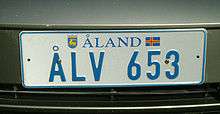
The State Department of Åland represents the Finnish central government and performs many administrative duties. It has a somewhat different function from the other Regional Administrative Agencies, owing to its autonomy. Before 2010, the state administration was handled by the Åland State Provincial Office.
Åland has its own postal administration but still uses the Finnish five-digit postal code system, using the number range 22000–22999, with the prefix AX. The lowest numbered postal code is for the capital Mariehamn, AX 22100, and the highest AX 22950 for Jurmo.
Municipalities
- Mariehamn (11,679)

- Jomala (5,233)

- Finström (2,593)

- Lemland (2,053)

- Saltvik (1,849)

- Hammarland (1,583)

- Sund (1,023)

- Eckerö (952)

- Föglö (531)

- Geta (496)

- Vårdö (447)

- Brändö (445)

- Lumparland (366)

- Kumlinge (314)

- Kökar (232)

- Sottunga (88)

Population as end of December, 2019.[28]
Geography
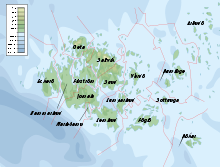
The Åland Islands occupy a position of strategic importance, as they command one of the entrances to the port of Stockholm, as well as the approaches to the Gulf of Bothnia, in addition to being situated near the Gulf of Finland.
The Åland archipelago includes nearly three hundred habitable islands, of which about eighty are inhabited; the remainder are merely some 6,200 skerries and desolate rocks.[12] The archipelago is connected to Åboland archipelago in the east (Finnish: Turunmaan saaristo, Swedish: Åbolands skärgård)—the archipelago adjacent to the southwest coast of Finland. Together they form the Archipelago Sea. To the West from Åland is the Sea of Åland and to the North is the Bothnian Sea.
The surface of the islands is generally rocky and the soil thin due to glacial stripping at the end of the most recent ice age.[12] The islands also contain many meadows that are home to many different kinds of insects, such as the Glanville fritillary butterfly. There are several harbours.

The islands' landmass occupies a total area of 1,527 square kilometres (590 sq mi).[29] Ninety percent of the population live on Fasta Åland, which is also the site of the capital town of Mariehamn. Fasta Åland is the largest island in the archipelago. Its area is difficult to estimate due to its irregular shape and coastline, but estimates range from 740 square kilometres[12] to 879 square kilometres[30] to over 1,010 square kilometres, depending on what is included or excluded.
During the Åland Islands dispute, the parties sought support from different maps of the islands. On the Swedish map, the most densely populated main island dominated, and many skerries were left out. On the Finnish map, many smaller islands or skerries were, for technical reasons, given a slightly exaggerated size. The Swedish map made the islands appear to be closer to the mainland of Sweden than to Finland; the Finnish map stressed the continuity of the archipelago between the main island and mainland Finland, while a greater gap appeared between the islands and the archipelago on the Swedish side. One consequence is the often repeated number of "over 6,000" skerries that was given authority by the outcome of the arbitration.
Climate
Åland has a humid continental climate that is influenced by its maritime position, especially in summer. While summers are cooler than on both the Swedish and Finnish mainland, winters see little difference to the adjacent parts of Sweden and are only narrowly milder than in mainland Finland.
| Climate data for Mariehamn (normals 1981–2010) | |||||||||||||
|---|---|---|---|---|---|---|---|---|---|---|---|---|---|
| Month | Jan | Feb | Mar | Apr | May | Jun | Jul | Aug | Sep | Oct | Nov | Dec | Year |
| Record high °C (°F) | 10.9 (51.6) |
10.5 (50.9) |
15.4 (59.7) |
21.1 (70.0) |
26.7 (80.1) |
29.4 (84.9) |
29.9 (85.8) |
30.7 (87.3) |
24.8 (76.6) |
19.0 (66.2) |
14.1 (57.4) |
10.1 (50.2) |
30.7 (87.3) |
| Average high °C (°F) | 0.3 (32.5) |
−0.3 (31.5) |
2.3 (36.1) |
7.4 (45.3) |
13.3 (55.9) |
17.2 (63.0) |
20.4 (68.7) |
19.4 (66.9) |
14.7 (58.5) |
9.5 (49.1) |
4.6 (40.3) |
1.7 (35.1) |
9.3 (48.7) |
| Daily mean °C (°F) | −2.5 (27.5) |
−3.5 (25.7) |
−0.9 (30.4) |
3.5 (38.3) |
8.5 (47.3) |
12.8 (55.0) |
16.2 (61.2) |
15.3 (59.5) |
10.9 (51.6) |
6.5 (43.7) |
2.2 (36.0) |
−1.0 (30.2) |
5.7 (42.3) |
| Average low °C (°F) | −5.3 (22.5) |
−6.6 (20.1) |
−4.1 (24.6) |
−0.5 (31.1) |
3.7 (38.7) |
8.2 (46.8) |
11.8 (53.2) |
11.1 (52.0) |
7.1 (44.8) |
3.5 (38.3) |
−0.2 (31.6) |
−3.7 (25.3) |
2.1 (35.8) |
| Record low °C (°F) | −32.3 (−26.1) |
−32.9 (−27.2) |
−25.0 (−13.0) |
−18.9 (−2.0) |
−6.5 (20.3) |
−2.2 (28.0) |
1.2 (34.2) |
0.5 (32.9) |
−6.7 (19.9) |
−11.8 (10.8) |
−20.0 (−4.0) |
−28.9 (−20.0) |
−32.9 (−27.2) |
| Average precipitation mm (inches) | 49.7 (1.96) |
31.4 (1.24) |
33.4 (1.31) |
28.6 (1.13) |
33.4 (1.31) |
52.3 (2.06) |
55.6 (2.19) |
75.1 (2.96) |
60.0 (2.36) |
68.1 (2.68) |
66.5 (2.62) |
56.5 (2.22) |
610.5 (24.04) |
| Source #1: Météo Climat[31] | |||||||||||||
| Source #2: Météo Climat[32] | |||||||||||||
Economy

Åland's economy is heavily dominated by shipping, trade and tourism. Shipping represents about 40% of the economy, with several international carriers owned and operated from Åland. Most companies aside from shipping are small, with fewer than ten employees. Farming and fishing are important in combination with the food industry. A few high-profile technology companies contribute to a prosperous economy. Wind power is rapidly developing, aiming at reversing the direction in the cables to the mainland in coming years. In December 2011, wind power accounted for 31.5% of Åland's total electricity usage.
The main ports are Mariehamn (south), Berghamn (west) and Långnäs on the eastern shore of the Main Island.
Mariehamn served as the base for the last large oceanic commercial sailing-ships in the world. Their final tasks involved bringing Australian wheat to Great Britain, a trade which Åland shipowner Gustaf Erikson kept going until 1947. The ships latterly made only one round-trip from South Australia to Britain per year, (the grain race), after each marathon voyage going back to Mariehamn to lay up for a few months. The ship Pommern, now a museum in Mariehamn, was one of these last vessels.
The abolition of tax-free sales on ferry boats travelling between destinations within the European Union made Finland demand an exception for the Åland Islands on the European Union value-added tax rules. The exception allows for maintained tax-free sales on the ferries between Sweden and Finland (provided they stop at Mariehamn or Långnäs) and at the airport, but has also made Åland a different tax-zone, meaning that tariffs must be levied on goods brought to the islands. Two million people visit the Åland Islands every year - but most of them just for a few hours before the ferry returns again, or the passengers change from one ship to another.[33]
Unemployment was 3.9% in January 2014[34]
The Finnish State also collects taxes, duties and fees in Åland. In return, the Finnish Government places a sum of money at the disposal of the Åland Parliament. The sum is 0.5% of total Government income, excluding Government loans. If the sum paid to the Finnish state exceeds 0.5%, then any amount above goes back to the Parliament of Åland as "diligence money".[35] In 2010 the amount of taxes paid by Åland Islanders comprised 0.7% of the total taxes paid in Finland.[36]
According to Eurostat, as of 2006 Åland was the 20th-wealthiest of the EU's 268 regions, and the wealthiest in Finland, with a GDP per inhabitant 47% above the EU mean.[37][38]
Bank of Åland is headquartered on the island.
While the official currency is the Euro, most businesses in Åland unofficially accept the Swedish krona.[39]
Demographics
Ethnicity and language
Most inhabitants speak Swedish (the sole official language) as their first language: 86.5% in 2019, while 4.7% spoke Finnish. The language of instruction in publicly financed schools is Swedish (In the rest of Finland, bilingual municipalities provide schooling both in Finnish and in Swedish). (See Åland Swedish for information about the dialect.)
The issue of the ethnicity of the Ålanders, and the correct linguistic classification of their language, remains somewhat sensitive and controversial. They may be considered either ethnic Swedes or Swedish-speaking Finns, but their language is closer to the Uppländska dialect of Sweden than to Finland Swedish. See Languages of Sweden.
Regional citizenship or the right of domicile (hembygdsrätt) is a prerequisite for voting, standing as a candidate for the Legislative Assembly, or owning and holding real estate situated in unplanned areas of Åland.[14]
Religion

The majority of the population, 72.0%, belongs to the Evangelical Lutheran Church of Finland.[40] The Åland islands contain Finland's oldest Christian churches, including St. Olaf's Church, Jomala, which dating from the late 13th century is likely to be the oldest in Finland. The Åland Islands' largest church is the Church of St. John in Sund, dating from shortly after.[41]
Culture
Sport

- Åland competes in the biennial Island Games, which it hosted in 1991 and 2009.
- Åland United (Women's football) and IFK Mariehamn (Men's football) are the islands' leading football clubs. IFK play in the Veikkausliiga, Finland's highest football league.
Åland Stags is the islands' only Rugby Union club.
See also
- Outline of the Åland Islands
- Index of Åland-related articles
- Bibliography of the Åland Islands
- Åland Islands dispute
- Åland Islands official football team
- Åland Swedish
- Coat of arms of Åland
- Languages of Åland
- Flag of Åland
- Government of Åland
- Provincial Governors of Finland
- Public holidays in Åland
- Transport on the Åland Islands
References
- Tim Vickery, Associated Press (18 July 2004) Deseret News.
- Hurst Hannum (1993). "Agreement between Sweden and Finland Relating to Guarantees in the Law of 7 May 1920 on the Autonomy of the Aaland Islands". Basic Documents on Autonomy and Minority Rights. Martinus Nijhoff Publishers. p. 141. ISBN 0-7923-1977-X.
- "Ennakkoväkiluku sukupuolen mukaan alueittain, helmikuu.2016". Pxnet2.stat.fi. Retrieved 31 March 2016.
- (PDF) https://www.asub.ax/sites/www.asub.ax/files/attachments/page/statistisk_arsbok_for_aland_2019_1.pdf. Missing or empty
|title=(help) - "Välkommen till ÅSUB! - Ålands statistik- och utredningsbyrå". Asub.ax. Retrieved 26 October 2017.
- "Sub-national HDI - Area Database - Global Data Lab". hdi.globaldatalab.org. Retrieved 13 September 2018.
- "Åland Islands". The American Heritage Dictionary of the English Language (5th ed.). Boston: Houghton Mifflin Harcourt. Retrieved 29 April 2019.
- "Åland" and "Åland Islands". Collins English Dictionary. HarperCollins. Retrieved 29 April 2019.
- "Åland Islands" (US) and {{Cite Oxford Dictionaries|Åland Islands|accessdate=29 April 2019}}
- "Åland". Merriam-Webster Dictionary. Retrieved 29 April 2019.
- "The Aland Islands". Osterholm.info. 9 May 2012. Archived from the original on 9 May 2012. Retrieved 26 October 2017.CS1 maint: BOT: original-url status unknown (link)
- Scheffel, Richard L.; Wernet, Susan J., eds. (1980). Natural Wonders of the World. United States of America: Reader's Digest Association, Inc. p. 3. ISBN 0-89577-087-3.
- An account of the border on Märket and how it was redrawn in 1985 appears in Hidden Europe Magazine, 11 (November 2006) pp. 26–29, ISSN 1860-6318
- "Act on the Autonomy of Åland" (PDF). Finlex. 1991. Retrieved 25 January 2017.
- "Åland in the European Union". Europe Information. Ministry for Foreign Affairs of Finland. 2013. p. 7. Retrieved 25 January 2017.
- Virrankoski, Pentti (2001). Suomen historia. Ensimmäinen osa. SKS. ISBN 951-746-321-9. p. 59.
- Lars Hulden (2001) Finlandssvenska bebyggelsenamn; Svenska litteratursällskapet i Finland. ISBN 951-583-071-0.
- "åland, the history". Aland Museum. Retrieved 15 January 2016.
- "Uneasy Sweden and the Menace of Prussianism; An Analysis of the Scandinavian Situation in View of Kaiser's Reported Ambition to Make the Baltic a German Lake" (PDF). Query.nytimes.com. Retrieved 26 October 2017.
- ch, Beat Müller, beat (at-sign) sudd (dot). "Åland-Inseln (Finnland), ??. Juni 1919 : Anschluss an Schweden [in German]". Sudd.ch. Retrieved 26 October 2017.
- F. S. Northedge, The League of Nations: Its Life and Times, 1920–1946 (Holmes & Meier, 1986, ISBN 978-0-7185-1316-0), pp 77, 78
- Elgán, Elisabeth (2015). Historical Dictionary of Sweden. Rowman & Littlefield. p. 26. ISBN 9781442250710.
- The recognition of states: law and practice in debate and evolution, Thomas D. Grant, illustrated, Greenwood Publishing Group, 1999, ISBN 0-275-96350-0, ISBN 978-0-275-96350-7, pp. 129–30
- "Product catalogue". Aland Stamps. Retrieved 10 February 2017.
- "The 2007 Session of the Nordic Council". European Tribune. 2007. Retrieved 10 February 2017.
- "International Prefixes". Radio Society of Great Britain. Retrieved 10 February 2017.
- "Allt fler hemundervisare flyttar till Åland". Ålandstidningen. Retrieved 12 August 2015.
- https://www.asub.ax/sites/www.asub.ax/files/attachments/page/statistisk_arsbok_for_aland_2019_1.pdf
- "Statistical Yearbook of Finland 2016" (PDF). Stat.fi. p. 505. Archived from the original (PDF) on 11 February 2017. Retrieved 7 February 2017.
- Europe, Council of (1 January 2012). Biodiversity and Climate Change: Reports and Guidance Developed Under the Bern Convention. Council of Europe. p. 251. ISBN 9789287170590.
- "Finland climate averages 1981–2010". Météo Climat.
- "Extreme values for Jomala Maarianahaminan Lentoansema". Météo Climat. 19 March 2017.
- Åland: many travellers, far fewer overnighters, Nordic Labour Journal, June 27, 2019
- "Archived copy" (PDF). Archived from the original (PDF) on 12 August 2014. Retrieved 12 August 2014.CS1 maint: archived copy as title (link)
- "Lagtingets uppgifter". Lagtinget.ax. 22 October 2015. Retrieved 26 October 2017.
- "Wayback Machine" (PDF). Web.archive.org. 13 March 2013. Archived from the original on 13 March 2013. Retrieved 26 October 2017.CS1 maint: BOT: original-url status unknown (link)
- "Wayback Machine" (PDF). Web.archive.org. 20 August 2012. Archived from the original on 20 August 2012. Retrieved 26 October 2017.CS1 maint: BOT: original-url status unknown (link)
- "Ahvenanmaa on EU:n 20. vaurain alue". Helsingin Sanomat. 19 February 2009. Retrieved 19 July 2009.
- Symington, Andy; Bain, Carolyn; Bonetto, Cristian; Ham, Anthony & Kaminski, Anna (2013), Scandinavia, Lonely Planet
- Key figures on population by region in 1990-2019 Statistics Finland
- "Churches in Åland". Muuka.com. Retrieved 26 October 2017.
External links
| Wikimedia Commons has media related to: |

- Åland official site (in English)
- Government of Åland (in Swedish)
- B7 Baltic Islands Network
- The example of Åland, autonomy as a minor protector The Åland example: autonomy protects a minority
- Ålandstidningen (local newspaper)
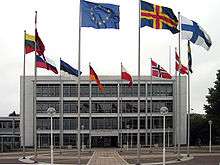
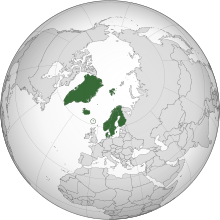

.svg.png)